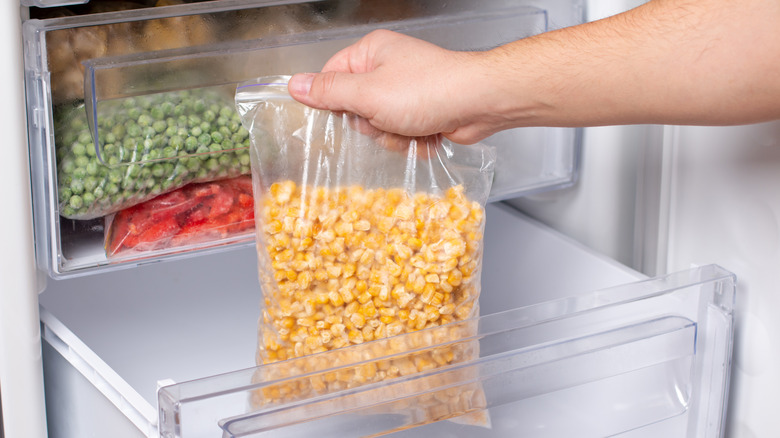The Reason Frozen Corn Is Often So Much Sweeter Than Fresh
From savory succotash to spicy elote, Americans love corn in all its forms. Whether it's fresh on the cob or ground into masa for tortillas, the U.S. has a huge appetite for the native vegetable, consuming around 12.4 billion bushels in 2021 and 2022, which is more than any other country by almost a billion bushels. Only China comes close at 11.57 billion bushels eaten in the same timeframe, according to Statista. Corn is an annual crop, so it's only grown and harvested once a year in the U.S., so when fresh cobs start showing up in the grocery store and farmer's markets it's a sure sign of summer.
You might be surprised to know, however, that when it comes to sweetness, frozen corn tends to come out on top compared to fresh corn. This is because it's frozen on the day that it's picked, which locks in the sugars. If you're making a recipe that calls for sweet corn, like a corn soufflé, unless you know your fresh corn was picked locally and recently you're better off using a bag of frozen corn. This is because fresh corn loses about a third or more of its sugar if it's not stored properly within 24 hours as it turns to starch, which mellows the flavor. The longer the corn sits around before it's eaten, the more sugar is lost.
Fresh versus frozen
There is a common misconception that frozen vegetables have less vitamins and minerals than their fresh counterparts. However, while fresh vegetables are delicious and appealing (which is why they put them at the front of most grocery stores), they are actually often lower in vital nutrients than frozen produce unless they're harvested locally. You've probably noticed how perishable items like avocados and bananas continue to change rapidly over time, and the same thing is true for corn, you just can't see it on the outside of the husk. Once the corn is picked, the starches in each kernel slowly convert into starch over time, which is a natural process of the seed getting ready to germinate. In fact, Iowa State says that most varieties of sweet corn can lose up to half of their sugar in the first 12 hours of being picked if they're not stored in refrigeration.
When corn is harvested, within a day or so some of it is shipped fresh to grocery wholesalers, some is flash frozen, and some is canned. That means that frozen corn's sugars are locked in time the minute they hit the freezer. On the other hand, a lot of fresh fruits and veggies are shipped in trucks around the country, which means it could be several days before your corn reaches the grocery store, and the flavor will definitely suffer.
When to use fresh and frozen corn
The nice thing about frozen corn is that it retains its texture and shape very well when it's frozen, so if you're making any recipe that calls for fresh corn kernels you can swap in frozen corn. It's also helpful that you can keep corn in the freezer and only take out what you need when you need it, and it's already cut away from the cob so it doesn't require any prep. Because it's as sweet as the day it was picked, frozen corn will taste great in recipes for corn chowder, corn salads, and added to pasta and rice dishes.
Fresh corn, however, can't be beat when it comes to clam bakes and backyard barbecues where you're eating the kernels right off the cob. You'll also need the structure of the cob to keep the kernels together if you want to make grilled corn or Mexican street corn, or trendy corn ribs. If you're making anything with fresh corn, try to buy it as close to the farm as possible to get the sweetest flavor, which shouldn't be too hard in the summer as it's grown in all 50 states. A good rule of thumb is to save your fresh sweet corn for eating off the cob — for everything else, keep a bag or two of frozen corn in the freezer as a secret weapon ingredient all year round.


